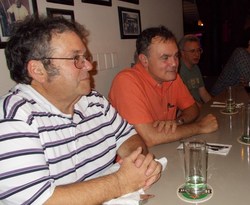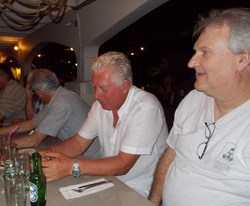 December 4, 2013 Editor: Ward Silver, NØAX | ||||||||
IN THIS ISSUE
NEW HF OPERATORS - THINGS TO DO Two of the most interesting HF bands play host to contests over the next two weekends: 10 meters and 160 meters. If you've listened during the week and think the band is closed, you might want to try again because when there are many hundreds of stations active, the bands come to life. Even if you are running low power or a modest antenna system, you'll make plenty of QSOs - come surprise yourself! BULLETINS It has been reported and confirmed that the world's largest amateur antenna, the 3-element 160 meter Yagi at OH8X, has collapsed in a recent storm. The Radio Arcala team is preparing a report that will be available in a few days. BUSTED QSOS No corrections to report this time. CONTEST SUMMARY Complete information for all contests follows the Conversation section Dec 7-8
Dec 14-15
Responding to many requests, the ARRL Programs & Services Committee accepted the Contest Advisory Committee's (CAC) recommendation to add Single-Operator Unlimited categories to the ARRL's 10 Meter, 160 Meter, RTTY Roundup, and the IARU's HF Championship contests. Previously, the use of spotting information placed a station in the Multioperator category. The new category takes effect with the RTTY Roundup contest in January 2014. This year's 160 Meter (Dec 6-8) and 10 Meter (Dec 14-15) contests are NOT affected by the change. (Thanks, ARRL CAC Chair, Al KØAD)
Dave K3ZJ found an inexpensive aid to increase his BIC (Butt In Chair) time, a key element of making good scores. He notes that it won't even change your category to Assisted or Unlimited: "For $1.99 I picked up a "lumbar back support" at the local Micro Center...it slips over any chair or car seat. I didn't expect much, but it is very comfortable." Would you like to do some holiday shopping and support a good cause at the same time? How about some WRTC2014 gear? Along with the regular items for sale, there are now two holiday specials that can be combined with year-end charitable, tax-exempt donations. The event is next July and the hosts are in the home stretch! Watch for the upcoming announcements of referee selections, too. (Thanks, WRTC2014 Co-Chair, Randy K5ZD) Fans of the "nerd pack" (a.k.a. pocket protector) will want to sharpen their pencils and pay a visit the online Museum of Pocket Protectors. (Thanks, Dan K7SS) There is a lot of history behind the electric car. Even though they are touted as new technology today, they substantially outnumbered gasoline-powered cars at the end of the 19th century. The EDN story, "Electric Vehicles -- Past, Present, and Future" by John Santini covers a lot of mileage from the early days of automobiles through today's designs and on to what tomorrow may deliver. Hal N4GG relays word of an iOS app called ISS Spotter that shows the current location of the ISS on maps. It also generates a forecast list for sightings from your current location, including inclination and azimuth for start and finish of the observation. The display is basically a compass with arrows pointing to the pass start and finish. Just take your phone outside and it tells you where to look. There are quite a few different satellite/ISS tracking apps as described in this Wikipedia list.
In an article that could affect your choice of radios, the Daily Mail reports that blue lights increase your alertness. Maybe on Sunday, you should use a radio with a blue backlight on the display? (Thanks, Norm W1ITT and Mike WWØYRR) Magazine Roundup
PC World reports the end of an era as the iconic Radio Store closes up shop in Tokyo's world-famous Akihabara District. Founded in 1950, the store provided components and electronic items to shoppers for 64 years. (Thanks, Norman W9VQ) Web Site of the Week - In the next World Wide Radio Operators Foundation webinar, Hank Garretson W6SX will describe a process for evaluating your antenna situation and making improvements based on your circumstances. Good stuff for Little Pistols, Medium Guns, and Big Guns alike. You can register for the free webinar which will be held on Tuesday, Dec 10 at 9 PM EST, equivalently 0200 UTC on Dec 11th. (Thanks, Ken K4ZW) WORD TO THE WISE Please be sure to check any response from log-acceptance systems to be sure your log is placed in the right category. For example, if an email robot confirms your entry as SOHP, the reply message will show something like "Single Operator, High Power". In contests without an Assisted or Unlimited category, logs for Single-Op entries with the Assisted tag present will usually wind up assigned to Multioperator. If this isn't your intent, be sure to correct the Cabrillo header information and re-submit the log until you are in agreement with the reply message...and save your confirmation number or ID! Fred HSØZAR/K3ZO sends a link to an excellent video of the November CQ WW CW operation from the shack of Stig HSØZGD/LA7JO in Phimai, which is in northeastern Thailand. The video was filmed and edited by Tony HSØZDX/G4UAV. (Thanks, Dave K3ZJ) Watch this video of the Temuco Radio Club on the air from Boroa-Chile, operating as XR6T in the October CQ WW SSB contest's Multi-Two category.
There are lots of contest videos from around the world. Just browse to YouTube and enter "CQ WW 2013" in the search window for lots more contest fun! Kirk K4RO found a set of Pace Company electronics rework training videos on YouTube. He says it's especially helpful for those of us who are not trained technicians. The material may be fairly dated as far as current manufacturing technology but is representative of and useful for many home and shack repair jobs. Learn Morse the Army way in Part 1 and Part 2 of this training film. It will help you get that "swinging kind of rhythm" so important to successful Morse operation. Don't forget to rest your elbow on the table! (Thanks, Howard N7SO) Records fell like ten-pins in the recent CQ WW CW contest according to the Raw Scores on the CQ WW website. (Remember that these are scores were calculated before log checking.) It sure looks like this was an African year in the Multioperator category! World M/S: CN2AA with 35M vs 27M (old record) U.S. M/2: K1LZ with 26.5M vs 21.5M Just 8 days after the 2013 CQ WW CW Contest the Contest Director, Randy K5ZD reports the committee has already received 7,187 logs! The raw scores offer an early indication of the results, but final scores could easily change by 5-15% (or more). Please send any feedback or corrections to questions@cqww.com.
Dan K1TO points out that the 1-2 finishers in the CQ WW CW World Single-Op Assisted, High Power, All-Band category are separated by less than a QSO's worth of points! EF8U...........13,932,261 It looks like this race will be decided in the log checking. With thanks to Dima RW3FO, the latest EU Sprint results are online. Contest Manager, Dave G4BUO reports a problem with the EU Sprint web site right now, but things are being repaired. SCC Contest Manager, Robert S57AW reports that official results for EU HF Championship 2013 are now ready, verified by the SCC Contest Committee, and published on the SCC web page. All UBN reports are publicly available as usual and everyone can print his or her own certificate online directly from the results. DX results of the 2013 ARI International DX Contest have been published. On the ARI web page, select HF -> Contest -> ARI International -> DX Results or access the results directly as a PDF file. (Thanks, ARI HF Contest Manager, Bob I2WIJ) Results for the 2013 CW Open have been posted. Please use the link near the top of the page to see the analysis, box scores and soapbox. Log checking reports are available by sending the committee an email. Worldwide activity was excellent in each of the three sessions and several records were broken by some of the best ops in the world. ICOM America continues the tradition of strong support for the CW Open and the organizers are extremely grateful for their sponsorship. (Thanks, CWO Manager, Dean NW2K) OPERATING TIP During the upcoming ARRL 10 Meter contest, the band looks like it will be open quite a bit if conditions hold up. The very short skip that allows you to work nearby stations beyond ground wave range may not be available, however. To work those stations, you'll need to use scatter modes. While scatter isn't usually an option for QRP stations, LP and HP stations might be able to make a contact if both stations are beaming in the same direction, preferably in the direction in which the band is open for long skip. Don't forget the skew path openings which are generally toward the magnetic equator from the direct path bearing! (Thanks, Bob KØRC and Barry W2UP) The following is a discussion from the RFI reflector on finding RFI from street lights by Frank Haas KB4T, a utility RFI investigator in Florida. With these RFI sources being a common irritant to the active contester, Frank's explanations and suggestions are good information: "As a Utility Interference Investigator, I run into bad street lights all the time. The most common failures are cycling and constant "invisible" RFI. Listening with a radio tuned to a quiet spot (or 1710) on the broadcast band, you can usually hear the repetitive street light symphony. Sometimes the RFI produced by these failed cycling lights can be heard as high as 325 MHz.
"In my region, the cycling street lights can produce the following sounds in a receiver. As the bulb first dimly lights, the RFI begins. In the receiver a broadband buzzing modulation can be heard that seems to have a low pitch. As the street light bulb increases in brightness, the pitch of the modulated RFI increases in lock step with the bulb's brightness. At full brightness the RFI's modulation reaches its highest pitch and greatest loudness. When the bulb goes out about 10 seconds later, the RFI stops. In 30 seconds to a minute, the process repeats. "When a street light produces constant, unchanging RFI, it can be heard strongest at low frequencies. Only 50% of the time have I been able to detect a street light producing constant RFI at frequencies above 50 MHz. The light DOES NOT need to be illuminated to produce this constant RFI. However, it's usually very easy to pinpoint the offending light...either the photocell or ballast are bad. "Like any other RFI source, finding a bad street light requires a portable/mobile receiver with RF Gain control, signal level indicator and directional antenna (or sensible technique based on signal strength). Not all street light RFI manifests itself as visible light. However, it can always be heard. Good DFing tools and technique will get the problem located promptly so repairs can be ordered." Fellow investigator, Mike Martin K3RFI, notes "The cycling lights are High Pressure Sodium (HPS) type and if cycling only at night the photocell is functioning properly. If the light cycles 24/7 the photocell is also bad. It's more common to be 24/7. The defective photocell causes the lights to fail earlier than normal. HPS bulbs are a common source of RFI on 40 and 80 meters and is (observed as) a single spike when using a scope. The cycling is caused by the element in the bulb opening when it gets hot. During the noise cycle the bulbs usually illuminate. This makes them easier to locate in the dark." Technical Web Site of the Week - As the designated electronic repair person in most households, you will enjoy this collection of helpful test hints for debugging that holiday hoo-doo, the bad light string. May this help you complete the job and get back to operating, watching football, raiding the fridge, or whatever you'd rather be doing! Count Your Radio Blessings I certainly hope a lot of my readers were able to get on the air for at least one of the recent contests since the re-awakening of Cycle 24 in mid-October. CQ World Wide SSB turned out to be just the first of a so-far-unbroken string of great contests. Both weekends of Sweepstakes were great and if you were on for the weekend of CQ World Wide CW, you know that was a spectacular contest, too, as the bands from 10 meters to 160 meters were jumping with activity around the world. If the dourer of the predictions about Cycle 25 and beyond come true, we may be talking about this contest season for a long time!
Certainly, there have been seasons with higher solar flux on average but this year the bands seem so incredibly full and contesters so happy (or maybe relieved is a better word). Participation has been on a steady upward trend for years and when the curtains part, the depth and breadth of the openings become apparent. Radiosport truly is a global hobby. Having been at this a while - like about a year (cough-cough) before I got my ham radio license and could be my own control operator - whether tuning the band or holding a frequency, to me contesting is a giant homecoming party of meeting one familiar call sign after another. Often a face flits into memory as the call is recognized. A quick handshake and off we go to the next QSO. I remember explaining at WRTC-1990 that I'd known many of the visiting hams for 20 years or more, realizing as I said it that my total cumulative interaction on the air during that time with some of them wasn't much more than a few minutes. Yet I felt like they were all members in the big radio family we all share. This is an important part of the story we need to emphasize to non-hams, new hams, and, yes, to each other. Ham radio is almost unique in that it demands a connection to exist. Regardless of whether your contact is over the poles on HF, via the Moon on UHF, or across the parking lot at millimeter wavelengths, it takes two to tango. Thus each of us, no matter what our operating or technical preferences, has much in common with every other ham.
During this era of wide and deep technological and social changes to our landscape, we must remember that the fundamentals underlying ham radio - summarized in the Basis and Purpose of FCC Part 97.1 - serve to unite us and remind us where the Good Arrow points. Those fundamentals are what we will carry into the future, through solar maxima and minimum, as digital and analog signals, at all frequencies and in all directions. In the face of change, let's not nit-pick things to death. The endless arguments about the most pure and true will never be resolved and only serve to divide us. Remember our accomplishments but use them as a guide to future exploration and successes. Don't let them be an anchor to the past. Instead of looking for things to complain about, count your ham radio blessings as reasons to share your enthusiasm, celebrating this exceptional hobby and our places within it. 4 December through 17 December An expanded, downloadable version of QST's Contest Corral in PDF format is available. Check the sponsor's Web site for information on operating time restrictions and other instructions. HF CONTESTS ARRL 160 Meter Contest--CW, from Dec 6, 2200Z to Dec 8, 1600Z. Bands (MHz): 1.8. Exchange: RST and ARRL/RAC section if US/VE. Logs due: Jan 1. Rules ARRL 10 Meter Contest--Phone,CW, from Dec 14, 0000Z to Dec 15, 2359Z. Bands (MHz): 28. Exchange: RS(T) and State/Prov or serial. Logs due: Jan 9. Rules TARA RTTY Mêlée--Digital, from Dec 7, 0000Z to Dec 7, 2359Z. Bands (MHz): 1.8-28. Exchange: RST and State/Province or serial. Logs due: Jan 1. Rules VU International DX Contest--Phone,CW, from Dec 7, 1200Z to Dec 8, 1200Z. Bands (MHz): 3.5-28. Exchange: RS(T) and Indian state or prefix. Logs due: Dec 26. Rules Top Operators Activity Contest--CW, from Dec 7, 1600Z to Dec 8, 1559Z. Bands (MHz): 3.5-28. Exchange: RST, serial, and TOPS/PRO number. Logs due: Dec 31. Rules AWA Bruce Kelly QSO Party--CW, from Dec 7, 2300Z - See website. Multiple time periods. Bands (MHz): 3.5,7. Exchange: RST, Xmtr type, power, name. Logs due: 30 days. Rules Ten Meter RTTY Contest--Digital, from Dec 8, 0000Z to Dec 8, 2359Z. Bands (MHz): 28. Exchange: RST and state or province or serial. Logs due: 7 days. Rules Straight Key Weekend Sprintathon--CW, from Dec 8, 1200Z to Dec 8, 2359Z. Bands (MHz): 3.5-28. Monthly beginning on the second Saturday local time. Exchange: RST, S/P/C, SKCC nr or power. Logs due: 5 days. Rules Great Colorado Snowshoe Run--CW, from Dec 8, 2100Z to Dec 8, 2259Z. Bands (MHz): 14. Exchange: RST, S/P/C, class, CQC number or power. Logs due: 30 days. Rules ARS Spartan Sprint--CW, from Dec 10, 0200Z to Dec 10, 0400Z. Bands (MHz): 3.5-28. Monthly on the first Monday evening local time. Exchange: RST, S/P/C, and power. Logs due: 2 days. Rules NAQCC Monthly QRP Sprint--CW, from Dec 11, 0130Z to Dec 11, 0330Z. Bands (MHz): 3.5-14. Monthly on 2nd Tuesday or 3rd Wednesday local time (alternating). Exchange: RST, S/P/C, and NAQCC mbr nr or power. Logs due: 4 days. Rules CWops Monthly Mini-CWT Test--CW, from Dec 11, 1300Z - See website. Multiple time periods. Bands (MHz): 1.8-28. Twice monthly on 2nd and 4th Wed, 18 to 28 kHz above band edge. Exchange: Name and member number or S/P/C. Logs due: 2 days. Rules NS Weekly Sprint--CW, from Dec 13, 0230Z to Dec 13, 0300Z. Bands (MHz): 1.8-14. Weekly on Thursday evenings local time. Exchange: Serial, name, and S/P/C. Logs due: 2 days. Rules 28 MHz SWL Contest--Phone,CW, from Dec 14, 0000Z to Dec 15, 2359Z. Bands (MHz): 28. Exchange: Log ARRL 10 Meter Contest QSOs. Logs due: Jan 31. Rules UBA Winter Contest--Phone,CW,Digital, from Dec 14, 1700Z - See website. Multiple time periods. Bands (MHz): 1.8-7. Exchange: RS(T) and UBA section or serial. Logs due: 3 weeks. Rules Holiday Spirits Homebrew Sprint--CW, from Dec 15, 2000Z to Dec 15, 2359Z. Bands (MHz): 1.8-28. Exchange: RST, S/P/C, ARCI number or Power. Logs due: 14 days. Rules Run For the Bacon--CW, from Dec 16, 0200Z to Dec 16, 0400Z. Bands (MHz): 1.8-28. Monthly on 3rd Sunday night (local). Exchange: RST, S/P/C, Flying Pig nr or power. Rules VHF+ CONTESTS Meteor Scatter Contest--Digital, from Dec 11, 0000Z to Dec 17, 0200Z. Bands (MHz): 50-222. Exchange: Both calls, grid square, acknowledgement. Logs due: Jan 15. Rules LOG DUE DATES 4 December through 17 December
ARRL Information Click here to advertise in this newsletter, space subject to availability. Your One-Stop Resource for Amateur Radio News and Information ARRL membership includes QST, Amateur Radio's most popular and informative journal, delivered to your mailbox each month. Subscribe to NCJ - the National Contest Journal. Published bimonthly, features articles by top contesters, letters, hints, statistics, scores, NA Sprint and QSO Parties. Subscribe to QEX - A Forum for Communications Experimenters. Published bimonthly, features technical articles, construction projects, columns and other items of interest to radio amateurs and communications professionals. Free of charge to ARRL members: Subscribe to The ARRL Letter (weekly digest of news and information), the ARES E-Letter (monthly public service and emergency communications news), Division and Section news -- and much more! ARRL offers a wide array of products to enhance your enjoyment of Amateur Radio. Visit the site often for new publications, specials and sales. Donate to the fund of your choice -- support programs not funded by member dues! Reprint permission can be obtained by sending email to permission@arrl.org with a description of the material and the reprint publication. ACKNOWLEDGEMENTS ARRL Contest Update wishes to acknowledge information from WA7BNM's Contest Calendar and SM3CER's Contest Calendar. | ||||||||
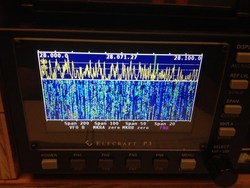
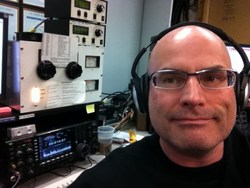
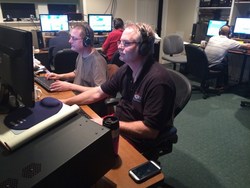
.jpg)

